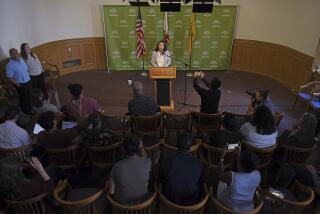In Oakland, young heroes seek justice
Oakland dodged a bullet last week after the verdict in the racially charged case of a young black man shot by a Bay Area Rapid Transit policeman.
The day ended with a few rubbish fires, looting at a Foot Locker and scattered broken windows downtown. But it was nothing like the mayhem after the shooting last year, when hundreds of looters rampaged for hours, ravaging businesses and torching cars.
FOR THE RECORD:
Los Angeles riots: Sandy Banksâ column in Saturdayâs Section A referred to the 1964 Los Angeles riots. They occurred in 1965. â
The response this time was a textbook case of collaboration. Downtown employees were sent home early to clear the area for protesters. Churches and civic groups organized forums to let residents vent. The family of the dead man issued public appeals for calm. And police turned out in such force, there seemed to be more officers than protesters.
But much of the credit belongs to Oaklandâs young people and to the adults who taught and trusted them.
Their campaign to promote nonviolence âreally made the difference,â said Ron Wakabayashi, a Department of Justice mediator. âThey seeded the community for peace.â
They soaked their neighborhood with peace messages and produced an anti-violence video that drew thousands of YouTube views. After the verdict, they roamed through the crowd downtown, handing out fliers that read âViolence Is Not Justice.â
These were kids hit hard by the death of Oscar Grant, who was on his way home from a New Yearâs Eve party when Johannes Mehserle shot him during a confrontation in a transit station.
Grant was like them, not exactly squeaky clean. He was on probation. Still, he had a job at a supermarket and a young daughter he doted on. The involuntary manslaughter verdict â less than the murder conviction prosecutors sought â disappointed and angered the cityâs youth.
But there they were, playing peacemaker â texting and Twittering to deploy to hotspots ahead of police, lining up for the microphone to tone down angry rhetoric; confronting a group trying to tip over a bus and convincing them to stop.
âThey helped people handle their feelings,â said Wakabayashi. They laid claim to their community, warning outsiders who came to make trouble, âThis is our city. Donât tear it up.â
And they asked themselves: What do we want Oakland to be remembered for?
*
Oscar Grant was Oaklandâs Rodney King. His shooting was captured on cellphone cameras and replayed endlessly in the city. The trial aroused such strong feelings and publicity that it had to be moved to Los Angeles.
âWhy young people here were so angry is that Oscar Grant could have been them,â said Jacky Johnson of Youth Uprising, a community group in East Oakland, where homicide is the leading cause of death for young people. âThe young black men in this community donât feel like their lives are worth anything.â
The Youth Uprising kids came around slowly to the notion of promoting peace. âAll we were hearing about was the preparation for rioting,â said program director Olis Simmons. âWe started talking, does it have to be that way?â
âIn the absence of leadership,â Simmons told the young people, âlead.â
Two things helped. The teenagers had been meeting for weeks with Oakland police officers in a program called Code 33 that aims to move both groups past stereotypes. Then Simmons partnered with the Urban Peace Movement to stage a daylong leadership forum the week before the trial ended.
The forum drew more than 100 young people and an unlikely mix of community leaders.
Alameda County Dist. Atty. Nancy OâMalley was there to explain the legal elements of the homicide case and the charges the jury would consider.
Former Black Panther Ericka Huggins reminded them that Oakland was the birthplace of the âblack powerâ movement and that future generations would be looking at what they did.
And Department of Justice officials used footage of Los Angeles riots â in 1964 and â93 â to show them the ugly face of urban fury. The images of brutality and futility of wrecking your own community resonated emotionally.
âWe wanted them to know: You are not powerless,â Simmons said. âAnd with power comes responsibility.â
They took that message to the streets.
âA lot of the people who showed up, their anger was right, but they didnât know what to do with it. They were frustrated,â said Joseph Johnson, 23. âWe talked to them about what the verdict meant, and how it looks to everyone else when we tear up our community.â
Javae Reed helped defuse a standoff between protesters and police when he spotted an officer he knew from Code 33. âThe other officers were pushing toward me to get back, then they saw us shaking hands and everything kind of calmed down,â said Reed, 19, who was in jail for robbery this time last year.
The Youth Uprising campaign took some heat. They were seen in some quarters as collaborators with the police. But they managed to move past that. Even a young woman whose brother was shot and killed by police was downtown passing out fliers urging peace.
Sheâs considered a traitor by her mother and sister. Her path, in their eyes, dishonors her brother. But it honors the community in hers.
They are still struggling with disappointment over the verdict. That was clear when I visited their center this week. Donât confuse understanding with acceptance, they told me. They know that itâs time to go beyond videos and slogans.
Violence Is Not Justice, their fliers said. Now theyâre to figure out what justice is.
More to Read
Sign up for Essential California
The most important California stories and recommendations in your inbox every morning.
You may occasionally receive promotional content from the Los Angeles Times.









